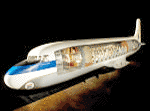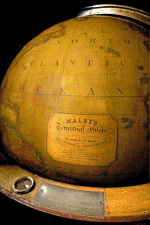|

Smithsonian's National Air and Space
Museum Invites Visitors from the World
Over to See "America by
Air"
 The
Smithsonian's National Air and Space
Museum will open its newest permanent
exhibition, "America by Air," on Saturday,
Nov. 17. With a dramatic array of
artifacts, photographs, artwork and
interactives&emdash;many at full
scale&emdash;the gallery will tell in
sweeping detail the story of passenger air
travel in the United States, from the
early attempts to form airlines only a
decade after Kitty Hawk to the commercial
challenges and technical sophistication of
the 21st-century jet age. The
Smithsonian's National Air and Space
Museum will open its newest permanent
exhibition, "America by Air," on Saturday,
Nov. 17. With a dramatic array of
artifacts, photographs, artwork and
interactives&emdash;many at full
scale&emdash;the gallery will tell in
sweeping detail the story of passenger air
travel in the United States, from the
early attempts to form airlines only a
decade after Kitty Hawk to the commercial
challenges and technical sophistication of
the 21st-century jet age.
The exhibition
will show how paying passengers got off
the ground after the development of air
mail; why the experience of air travel
changed throughout the years from a
luxurious adventure to a less-glamorous
necessity; and how current events will
affect the way people fly for years to
come.
As part of the
gallery experience, visitors will be able
to cross a 30-foot-high pedestrian bridge
and step inside the forward fuselage of a
retired Northwest Boeing 747, getting a
close-up look at the cockpit along with
the view from the upper deck of the
wide-body airliner that became an icon of
the "jet set" era.
Also featured in
the new exhibition will be a life-size
interactive cockpit simulation of an
Airbus A320 taking off and landing at
Ronald Reagan Washington National Airport.
The graphics seen through the windshield
show the nation's capital and its
landmarks in remarkable
detail.
With the help of
a specially built platform installed in
the gallery, visitors looking up at the
hanging Ford 5-AT Tri-Motor will be able
to feel and hear the continuous heavy
vibrations that rattled travelers aboard
the classic "Tin Goose" beginning in the
mid-1920s. Next to the platform will be a
life-size profile of the airplane with a
cutaway showing the interior
seating.
"Passenger air
travel is so ingrained in our culture,
it's natural that we take its development
and success for granted," museum director
Gen. J.R. "Jack" Dailey said. "'America by
Air' reminds us how no other machine but
the airliner put the far corners of the
world within reach for so many. It's
impossible to imagine modern life without
it, and it's hard not to relate instantly
to this new gallery."
The exhibition
will be divided into four thematic
sections: Early Years, 1914-1927;
Expansion and Innovation, 1927-1941;
Piston-Engine Era, 1941-1958; and Jet Age,
1958-Today.
Among the many
interactive features, animated maps on
large, high-definition screens will
present a compressed day-in-the-life of
today's complex airline routes and how
they can be affected by bad weather. The
same displays will show visitors how air
traffic control cleared the skies over the
United States on Sept. 11, 2001, in just a
few unprecedented hours.
Visitors also
will be able to spin and compare models of
piston and jet engines and test the
differences between control systems from
simple lever-and-wires to hydraulics to
NASA-developed, computer-based,
fly-by-wire technology.
Many of the
exhibition's interactive features will be
available on the museum's Web site,
www.nasm.si.edu.
In addition to
the 747 nose and the forward fuselage of a
DC-7, whose interior also will be open to
the public, the exhibition will display
seven complete airplanes to represent the
formative years of air transportation in
the United States: the Ford Tri-Motor; a
Curtiss JN-4D Jenny; a Pitcairn PA-5
Mailwing; a Fairchild FC-2; a Northrop
Alpha; a Boeing 247-D; and a Douglas
DC-3.
While most of the
aircraft will be displayed hanging from
ceiling trusses, the Jenny will be set
much closer to eye level on supports just
outside an improvised airmail hut. Surplus
Jennys from World War I became the first
aircraft used in regular service by the
U.S. Post Office Department. The museum's
JN-4D, in pristine, unrestored condition,
was last displayed by the Smithsonian
during the 1960s.
Several key
passenger airplane engines from the 1920s
to the 1970s will be displayed in the
gallery, including the trailblazing 1926
Wright Whirlwind and a Rolls-Royce RB.211
high-bypass turbofan.
The exhibition
also will spotlight some of the
personalities who turned air travel into
an industry and a culture. Visitors will
learn of the less-heralded work of Charles
Lindbergh, who helped chart some of the
nation's initial airline routes. The
gallery also remembers pioneers like Ellen
Church, who suggested putting nurses like
her in the sky as the first stewardesses;
and pilot Marlon Green, who broke the
major carriers' whites-only barrier in
1965 with a discrimination suit against
Continental Airlines.
Highlights from
the museum's extensive air travel poster
collection will illustrate how airline
advertisements initially focused on issues
of safety and comfort but&emdash;as
passengers grew increasingly
savvy&emdash;gradually shifted their focus
to destinations.
"America by Air"
also recalls how the federal government's
role in commercial air travel evolved from
establishing air traffic control and early
regulation aimed at encouraging growth to
creating valuable technologies through the
National Advisory Committee for
Aeronautics, the predecessor to NASA. A
large "NACA" sign on display comes from
one of the landmark Langley, Va., wind
tunnels that helped produce breakthroughs
in aircraft design in the 1920s and
1930s.
With a variety of
evocative displays, the exhibition will
put in context the airliner's crucial role
in swiftly moving time-sensitive cargo
like transplant organs, produce and
seafood. The Washington Nationals baseball
club has donated bats, a helmet, a team
jacket and an equipment travel bag to
represent how modern aircraft dramatically
streamlined the road trip and expanded the
reach of professional
sports.
Special photo
opportunities for visitors will be
available throughout the gallery,
including cutouts of soot-covered airmail
pilots and traveling stars from
Hollywood's golden era. An airline
chewing-gum dispenser, complimentary
flight bags, a travel insurance vending
machine and provocative stewardess
uniforms from the 1960s and 1970s also
help tell the exhibition's
story.
To explain the
economics of the post-deregulation era, an
interactive price "meter" will challenge
visitors to spend $300 or less on a plane
ticket while deciding whether they can do
without such comforts as a non-stop
flight, sufficient leg room and food
service. An "In the News" section in the
gallery and on the exhibition Web site
will provide information on the latest
innovations and events in air
travel.
The "America by
Air" exhibition will be the subject of a
special themed Family Day on Nov. 17, with
activities including curator presentations
and storytimes for young
visitors.
That weekend
before Thanksgiving will be dedicated to
the latest Smithsonian offerings as the
National Museum of Natural History opens
its special "Butterflies and Plants"
enclosed pavilion and the Donald W.
Reynolds Center for American Art and
Portraiture unveils the new enclosed
Robert and Arlene Kogod
Courtyard.
"America by Air"
is made possible through the generous
support of the National Aeronautics and
Space Administration; the U.S. Department
of Transportation; and Airbus. Additional
support is provided by the Federal
Aviation Administration and Rockwell
Collins.
Northwest
Airlines generously donated the 747 whose
forward fuselage is displayed in the
gallery.
The National Air
and Space Museum building on the National
Mall in Washington D.C., is located at
Sixth Street and Independence Avenue S.W.
The museum's Steven F. Udvar-Hazy
Center&emdash; home to a number of
historic commercial airplanes, including a
Concorde, the Boeing Stratoliner 307 and
the "Dash 80" original prototype for the
Boeing 707&emdash;is located in Chantilly,
Va., near Washington Dulles International
Airport.
Both facilities
are open daily from 10 a.m. to 5:30 p.m.
(Closed Dec. 25) Admission is free but
there is a $12 fee for daily parking at
the Udvar-Hazy Center.
|

